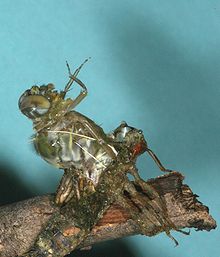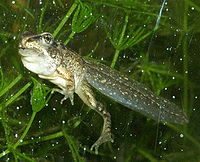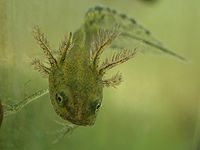- Metamorphosis
-
Metamorphosis is a biological process by which an animal physically develops after birth or hatching, involving a conspicuous and relatively abrupt change in the animal's body structure through cell growth and differentiation. Some insects, amphibians, molluscs, crustaceans, Cnidarians, echinoderms and tunicates undergo metamorphosis, which is usually accompanied by a change of habitat or behavior.
Scientific usage of the term is exclusive, and is not applied to general aspects of cell growth, including rapid growth spurts. References to "metamorphosis" in mammals are imprecise and only colloquial, but historically idealist ideas of transformation and monadology, as in Goethe's Metamorphosis of Plants, influenced the development of ideas of evolution.
Contents
Etymology
The word "metamorphosis" derives from Greek μεταμόρφωσις, "transformation, transforming",[1] from μετα- (meta-), "change" + μορφή (morphe), "form".[2]
Insect metamorphosis
All insects in the Pterygota undergo a marked change in form, texture and physical appearance or metamorphosis, from immature to adult. These insects either have hemimetabolous development, and undergo an incomplete or partial metamorphosis, or holometabolous development, which undergo a complete metamorphosis, including a pupal or resting stage between the larval and adult forms.[3]
In hemimetabolous insects, immature stages are called nymphs. Development proceeds in repeated stages of growth and ecdysis (moulting); these stages are called instars. The juvenile forms closely resemble adults, but are smaller and lack adult features such as wings and genitalia. This process is known as "partial" or "incomplete" metamorphosis. The differences between nymphs in different instars are small, often just differences in body proportions and the number of segments, although external wing buds will form in later instars.
In holometabolous insects, immature stages are called larvae, and differ markedly from the adults. Insects which undergo holometabolism pass through a larval stage, then enter an inactive state called pupa, or chrysalis, and finally emerge as adults. This process is called "complete" metamorphosis. It is theorized that the pupal stage is the evolutionary compaction of all the nymphal stages of their hemimetabolous ancestors, while the larval stage is an extended, mobile form of the developing embryo[4].
According to recent research, adult Manduca sexta is able to retain the behaviour learned as a caterpillar.[5]
Many observations have indicated that programmed cell death plays a considerable role during physiological processes of multicellular organisms, particularly during embryogenesis and metamorphosis.
Hormonal control
Insect growth and metamorphosis are controlled by hormones synthesized by endocrine glands near the front of the body.
Neurosecretory cells in an insect's brain secrete a hormone, the prothoracicotropic hormone (PTTH) that activates prothoracic glands, which secrete a second hormone, usually Ecdysone (a ecdysteroid), that induces ecdysis.
PTTH also stimulates the corpora allata, a retrocerebral organ, to produce juvenile hormone (JH), which prevents the development of adult characteristics during ecdysis. In holometabolous insects, molts between larval instars have a high level of JH, the moult to the pupal stage has a low level of JH, and the final, or imaginal, molt has no JH present at all.[6]
Amphibian metamorphosis
In typical amphibian development, eggs are laid in water and larvae are adapted to an aquatic lifestyle. Frogs, toads, and newts all hatch from the egg as larvae with external gills. Afterwards, newt larvae start a predatory lifestyle, while tadpoles mostly scrape food off surfaces with their horny tooth ridges.
Metamorphosis in amphibians is regulated by thyroxin concentration in the blood, which stimulates metamorphosis, and prolactin, which counteracts its effect. Specific events are dependent on threshold values for different tissues. Because most embryonic development is outside the parental body, development is subject to many adaptations due to specific ecological circumstances. For this reason tadpoles can have horny ridges for teeth, whiskers, and fins. They also make use of the lateral line organ. After metamorphosis, these organs become redundant and will be resorbed by controlled cell death, called apoptosis. The amount of adaptation to specific ecological circumstances is remarkable, with many discoveries still being made.
Frogs and toads
With frogs and toads, the external gills of the newly hatched tadpole are covered with a gill sac after a few days, and lungs are quickly formed. Front legs are formed under the gill sac, and hindlegs are visible a few days later. Following that there is usually a longer stage during which the tadpole lives off a vegetarian diet. Tadpoles use a relatively long, spiral‐shaped gut to digest that diet.
Rapid changes in the body can then be observed as the lifestyle of the frog changes completely. The spiral‐shaped mouth with horny tooth ridges is resorbed together with the spiral gut. The animal develops a big jaw, and its gills disappear along with its gill sac. Eyes and legs grow quickly, a tongue is formed, and all this is accompanied by associated changes in the neural networks (development of stereoscopic vision, loss of the lateral line system, etc.) All this can happen in about a day, so it is truly a metamorphosis. It isn't until a few days later that the tail is reabsorbed, due to the higher thyroxin concentrations required for tail resorption.
Newts
In newts, there is no true metamorphosis because newt larvae already feed as predators and continue doing so as adults. Newts' gills are never covered by a gill sac and will be resorbed only just before the animal leaves the water. Just as in tadpoles, their lungs are functional early, but newts don't make as much use of them as tadpoles do. Newts often have an aquatic phase in spring and summer, and a land phase in winter. For adaptation to a water phase, prolactin is the required hormone, and for adaptation to the land phase, thyroxin. External gills do not return in subsequent aquatic phases because these are completely absorbed upon leaving the water for the first time.
Metamorphosis in fish and invertebrate aquatic animals
Little known is that also fish, i.e. both bony fish and non-bony fish Superclass, undergo metamorphosis. Fish metamorphosis is typically under strong control by thyroid hormone. Examples include the (non-bony fish) Agnatha and lamprey and one bony fish the salmon, which must change from a freshwater to saltwater lifestyle (diadromous). Additionally, the flatfish begins its life bilaterally symmetrical, and one eye must move to join the other side of the fish in its adult form. The European eel has a number of metamorphoses, from the larval stage to the leptocephalus stage, then a quick outspoken metamorphosis from leptocephalus to glass eel at the edge of the continental shelf (8 days for Japanese eel), two months at the border of fresh and salt water the glass eel undergoes a quick metamorphosis into elver, which then has a long stage of growth followed by a more gradual metamorphosis to the migrating phase. In the pre-adult fresh water stage it also has phenotypic plasticity because fish eating eels develop very wide mandibles, making the head look blunt. Leptocephali are very common and a common phase for all Elopomorpha (Tarpon- and eellike fishes). Most bony fishes undergo metamorphosis after absorption of the yolk sac because after that phase they need to be able to feed for themselves.
See also
References
- ^ Metamorphosis, Henry George Liddell, Robert Scott, A, at Perseus
- ^ Online Etymology Dictionary
- ^ Gullan, P. J. & Cranston, P. S. 6.2 Life History Patterns and Phases in The Insects: An Outline of Entomology. pp. 143-153. 2005 by Blackwell Publishing
- ^ Gullan, P. J. & Cranston, P. S. 6.2 Life History Patterns and Phases in The Insects: An Outline of Entomology. pp. 143-153. 2005 by Blackwell Publishing
- ^ Douglas J. Blackiston, Elena Silva Casey & Martha R. Weiss (2008). "Retention of memory through metamorphosis: can a moth remember what it learned as a caterpillar?". PLoS ONE 3 (3): e1736. doi:10.1371/journal.pone.0001736. PMC 2248710. PMID 18320055. http://www.plosone.org/article/info%3Adoi%2F10.1371%2Fjournal.pone.0001736.
- ^ Gullan, P.J. & Cranston, P.S. 6.3 Process and Control of Moulting in The Insects: An Outline of Entomology. pp. 153-156 2005 by Blackwell Publishing
- ^ Mader, Sylvia, Biology 9th ed.Ch. 31
- Davies, R.G., "Outlines of Entomology", Chapman and Hall: chapter 3
- Williamson D I (2003). "The Origins of Larvae", xviii + 261 pp, ISBN 1-4020-1514-3. Kluwer. Dordrecht.
External links
- Description of metamorphosis and its different forms
- Info on butterflies and butterfly metamorphosis
- Info on insect hormones
Developmental biology Embryology Embryogenesis (Human embryogenesis · Drosophila embryogenesis · Fish embryogenesis) · Polarity in embryogenesisOther Categories:- Developmental biology
- Animal anatomy
- Greek loanwords
Wikimedia Foundation. 2010.









